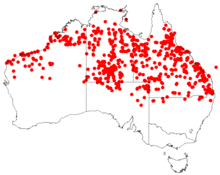Indigofera linnaei
Indigofera linnaei, known as Birdsville indigo and nine-leaved indigo, is a species of leguminous shrub in the genus Indigofera (family Fabaceae). The genus name, Indigofera, is derived from Latin and means bearing/containing indigo (a purple dye originally obtained from some Indigofera species), while linnaei derives from Linnaeus.
| Indigofera linnaei | |
|---|---|
.jpg) | |
| Scientific classification | |
| Kingdom: | Plantae |
| Clade: | Tracheophytes |
| Clade: | Angiosperms |
| Clade: | Eudicots |
| Clade: | Rosids |
| Order: | Fabales |
| Family: | Fabaceae |
| Genus: | Indigofera |
| Species: | I. linnaei |
| Binomial name | |
| Indigofera linnaei | |
 | |
| Australian occurrence data from Australasian Virtual Herbarium[3] | |
| Synonyms[4] | |
| |
It is found in throughout South East Asia, extending through the various archipelagos to Australia, where it is widespread in the northern part of the continent.[5][6]
Distribution
It is found in Assam, Bangladesh, Bismarck Archipelago, China, Himalaya, Hainan, India, Indonesia, Laos, Lesser Sunda Islands, Maldives, Myanmar, Nepal, New Guinea, Pakistan, Sri Lanka, Sudan, Sulawesi, Thailand, Vietnam, and Australia.[4] Within Australia it is found in Queensland, Western Australia, the Northern Territory, New South Wales,[4][7] and South Australia.[7]
Description
Indigofera linnaei is a spreading, usually prostrate woody herb, 15–50 cm high with a long taproot,[8] which forms a flat mat up to 1.5 m across, and up to 45 cm high.[6] The compound leaves are up to 3 cm long, with (generally) 7 or 9 obovate, alternate leaflets which have a mucronate apex and are about 8–15 mm long and 2–5 mm wide. The stipules are lanceolate (shaped like a lance-head) and about 5 mm long with broad, dry margins.[8][9] The inflorescences are dense and up to 2 cm long. The calyx is covered with spreading, white hairs. The petals are red.[8] The standard slightly exceeds the calyx, and the wings and keel are shorter.[9] The pod is oblong and silky, about 3–7 mm long, pointed at apex, and usually contains two seeds.[8]
The branches are covered with appressed white hairs; leaves peltate, 3–5 cm long; leaflets 7-9, obovate-cuneate, 8-13 x 2–5 mm, mucronate, sericeous on both sides; stipules c. 3 mm long, lanceolate, lateral, free, sericeous. The inflorescence is a subsessile, dense, a glomerule-like spike, 1–2 cm long. It is few- to 25-flowered, with bracts lanceolate, 3–4 mm long, pubescent, scarious, with a strong central vein terminating in an acuminate tip. The flowers are sessile, about 5 mm long; calyx campanulate, 3–5 mm long, villous, the narrow acuminate teeth much longer than the tube. The petals red; standard obovate-spathulate, slightly exceeding the calyx; wings and keel shorter, inserted.[9]
In the Northern Territory, it is a weedy species often found in disturbed or overgrazed areas and on a variety of soils from skeletal soils and red sand to cracking clay.[10] It flowers and fruits in all months of the year.[10]
In Western Australia it flowers from January to May, and is found on sandy soils, on sandstone & limestone ridges, along rives and creeks, and on rocky hillsides.[11] It is not considered a species of conservation concern in Western Australia to according to the Declared Rare and Priority Flora List.[11]
Toxicity
It took considerable time before it was recognised as the plant which gave horses the "Birdsville" disease (a disease of horses in arid and semi-arid Australia),[12] with the causal agent being suspected by Everist[6] as being indospicene[13] or possibly cavananine.[6] However, current research indicates that the neurotoxic effects on horses with Birdsville disease are due to the neurotoxin 3 nitropropionic acid (3-NPA), with horses less susceptible than cattle to the hepatotoxic effects of indospicene.[12] The neurotoxic effect on horses generally occurs just after the rains, because I. linneai responds more quickly to moisture than other species.[12]
Nonetheless, Indospicine accumulates in the tissues of grazing livestock after ingestion of Indigofera, causing both liver degeneration and abortion across animal species but the degree varies considerably between species. The magnitude of sensitivity in dogs is such that consumption of indospicine-contaminated horse and camel meat has caused secondary poisoning of dogs.[14] Livestock grazing Indigofera have a chronic and cumulative exposure to this toxin, with such exposure experimentally shown to induce both hepatotoxicity and embryo-lethal effects in cattle and sheep.[14]
References
- "Indigofera linnaei". Australian Plant Name Index (APNI), IBIS database. Centre for Plant Biodiversity Research, Australian Government. Retrieved 18 November 2018.
- Ali, S.I. (1958), Revision of the genus Indigofera L. from W. Pakistan and N.W. Himalayas. Botaniska Notiser 111: 549. Retrieved 18 November 2018.
- The Australasian Virtual Herbarium – Occurrence data for Indigofera linnaei
- Govaerts, R. et. al. (2018) Plants of the world online: Indigofera linnaei. Board of Trustees of the Royal Botanic Gardens, Kew. Retrieved November 18, 2018.
- GBIF: Indigofera linnaei Ali. GBIF Secretariat: GBIF Backbone Taxonomy. Retrieved 17 November 2018.
- Everist, S.L. (1979) Poisonous Plants of Australia (2nd ed.) pp.447-450. Angus and Robertson Publishers, Melbourne.
- The Australasian Virtual Herbarium – Occurrence data for Indigofera linnaei. Retrieved November 18, 2018.
- Peter G. Wilson, P.G. (1991) PlantNET: Indigofera linnaei. Data derived from Flora of NSW 2, National Herbarium of NSW, Royal Botanic Garden, Sydney. Retrieved November 18, 2018.
- SA Flora: Indigofera linnaei. Electronic Flora of South Australia species Fact Sheet. Retrieved November 18, 2018.
- NTFlora: Indigofera linnaei. Northern Territory Flora online, Northern Territory Government. Retrieved 17 November 2018
- "Indigofera linnaei". FloraBase. Western Australian Government Department of Parks and Wildlife. Retrieved 17 November 2018.
- "Agnote: Birdsville Disease" (PDF). 2010. Retrieved 20 November 2018.
- PubChem:Compound Summary for CID 108010 Indospicine. Retrieved 20 November 2018.
- Fletcher, M.; Al Jassim, R.; Cawdell-Smith, A. (2015). "The Occurrence and Toxicity of Indospicine to Grazing Animals". Agriculture. 5 (3): 427–440. doi:10.3390/agriculture5030427. ISSN 2077-0472.